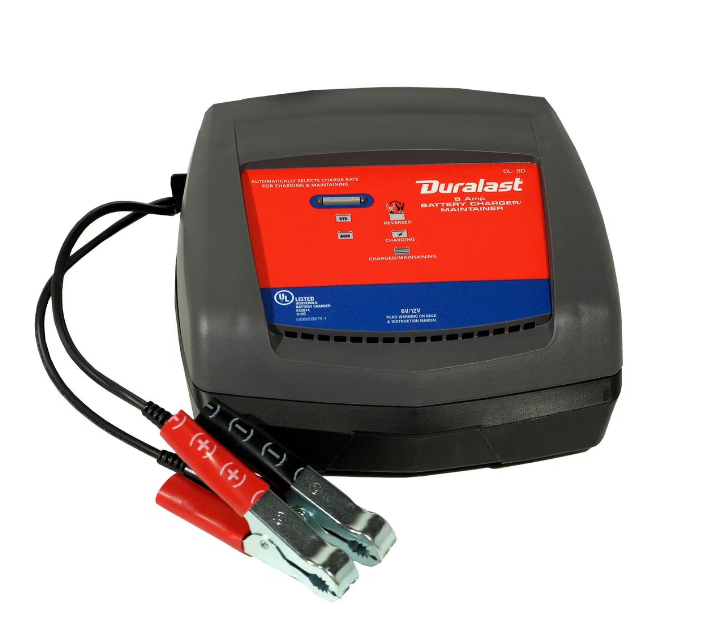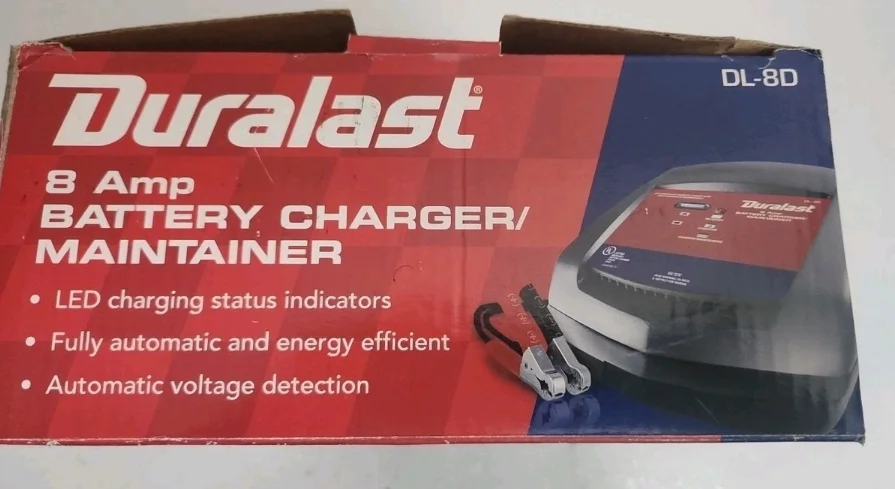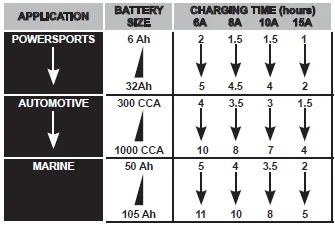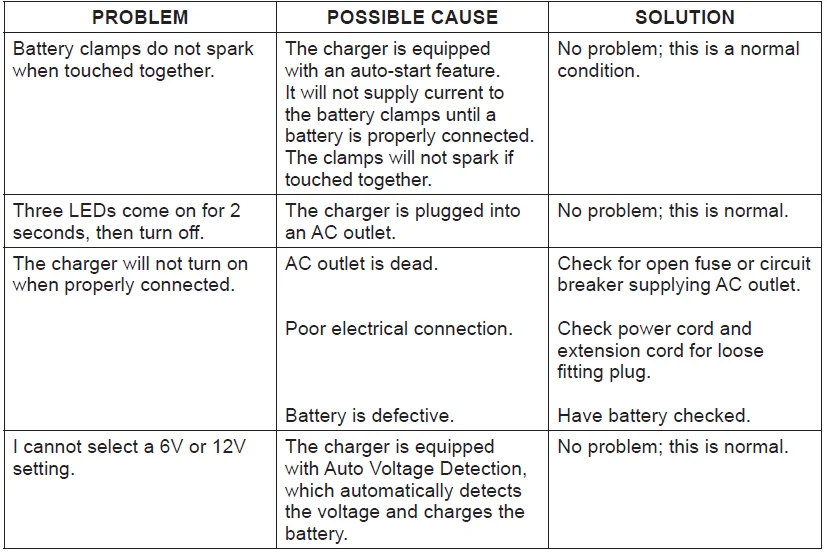![]()
Duralast DL-8D 8 Amps Vehicle Battery Charger

IMPORTANT SAFETY INSTRUCTIONS
- This charger is not intended for use by children.
- Do not expose the charger to rain or snow.
- Use of an attachment not recommended or sold by the battery charger manufacturer may result in a risk of fire, electric shock, or injury to persons.
- To reduce the risk of damage to the electric plug and cord, pull by the plug rather than the cord when disconnecting the charger.
- An extension cord should not be used unless absolutely necessary. Use of an improper extension cord could result in a risk of fire and electric shock. If an extension cord must be used, make sure:
- The pins on the plug of the extension cord are the same number, size, and shape as those of the plug on the charger.
- The extension cord is properly wired and in good electrical condition.
- The wire size is large enough for the AC ampere rating of the charger as specified in section 8.
- Do not operate the charger with a damaged cord or plug – replace the cord or plug immediately.
- Do not operate the charger if it has received a sharp blow, been dropped, or otherwise damaged in any way; take it to a qualified serviceman.
- Do not disassemble the charger; take it to a qualified serviceman when service or repair is required. Incorrect reassembly may result in a risk of electric shock or fire.
- To reduce the risk of electric shock, unplug the charger from the outlet before attempting any maintenance or cleaning. Turning off controls will not reduce this risk.
PERSONAL SAFETY PRECAUTIONS
- Consider having someone close enough by to come to your aid when you work near a lead-acid battery.
- Have plenty of fresh water and soap nearby in case battery acid contacts skin, clothing, or eyes.
- Wear complete eye protection and clothing protection. Avoid touching your eyes while working near a battery.
- If battery acid contacts skin or clothing, wash immediately with soap and water. If acid enters the eye, immediately flood the eye with running cold water for at least 10 minutes and get medical attention immediately.
- NEVER smoke or allow a spark or flame in the vicinity of the battery or engine.
- Be extra cautious to reduce the risk of dropping a metal tool onto the battery. It might spark or short-circuit the battery or other electrical parts, which may cause an explosion.
- Remove personal metal items such as rings, bracelets, necklaces, and watches when working with a lead-acid battery. A lead-acid battery can produce a short-circuit current high enough to weld a ring or the like to metal, causing a severe burn.
- Use the charger for charging only 6V and 12V LEAD-ACID (STD or AGM) rechargeable batteries. It is not recommended for batteries smaller than 12Ah. It is not intended to supply power to a low-voltage electrical system other than in a starter-motor application. Do not use a battery charger for charging dry-cell batteries that are commonly used with home appliances. These batteries may burst and cause injury to persons and damage to property.
- NEVER charge a frozen battery.
PREPARING TO CHARGE
- If necessary to remove the battery from the vehicle to charge, always remove the grounded terminal from the battery first. Make sure all accessories in the vehicle are off, so as not to cause an arc.
- Be sure the area around the battery is well ventilated while the battery is being charged.
- Clean battery terminals. Be careful to keep corrosion from coming in contact with your eyes.
- Add distilled water in each cell until the battery acid reaches the level specified by the battery manufacturer. Do not overfill. For a battery without removable cell caps, such as valve-regulated lead-acid batteries, carefully follow the manufacturer’s recharging instructions.
- Study all battery manufacturers’ specific precautions while charging and recommended rates of charge.
- Determine the voltage of the battery by referring to the car owner’s manual and make sure that the output voltage selector switch is set at the correct voltage. If the charger has an adjustable charge rate, charge the battery initially at the lowest rate.
CHARGER LOCATION
- Locate the charger as far away from the battery as DC cables permit.
- Never place a charger directly above a battery being charged; gases from the battery will corrode and damage the charger.
- Never allow battery acid to drip on the charger when reading electrolyte specific gravity or filling the battery.
- Do not operate the charger in a closed-in area or restrict ventilation in any way.
- Do not set a battery on top of a charger.
DC CONNECTION PRECAUTIONS
- Connect and disconnect DC output clips only after setting any charger switches to the “off” position and removing the AC cord from electric outlet. Never allow clips to touch each other.
- Attach clips to the battery and chassis, as indicated in sections 6 and 7.
FOLLOW THESE STEPS WHEN THE BATTERY IS INSTALLED IN VEHICLE
WARNING: A SPARK NEAR THE BATTERY MAY CAUSE A BATTERY EXPLOSION. TO REDUCE THE RISK OF A SPARK NEAR THE BATTERY:
- Position the AC and DC cords to reduce the risk of damage from the hood, door, or moving engine parts.
- Stay clear of fan blades, belts, pulleys, and other parts that can cause injury to persons.
- Check the polarity of battery posts. POSITIVE (POS, P, +) battery post usually has a larger diameter than NEGATIVE (NEG, N,–) post.
- Determine which post of the battery is grounded (connected) to the chassis. If the negative post is grounded to the chassis (as in most vehicles). If a positive post is grounded to the chassis.
- For a negative-grounded vehicle, connect the POSITIVE (RED) clip from the battery charger to the POSITIVE (POS, P, +) ungrounded post of battery. Connect NEGATIVE (BLACK) clip to vehicle chassis or engine block away from battery. Do not connect the clip to the carburetor, fuel lines, or sheet-metal body parts. Connect to a heavy-gauge metal part of the frame or engine block.
- For a positive-grounded vehicle, connect the NEGATIVE (BLACK) clip from the battery charger to the NEGATIVE (NEG, N, –) ungrounded post of the battery. Connect the POSITIVE (RED) clip to the vehicle chassis or engine block away from the battery. Do not connect the clip to the carburetor, fuel lines, or sheet-metal body parts. Connect to a heavy-gauge metal part of the frame or engine block.
- When disconnecting the charger, turn the switches off, disconnect the AC cord, remove the clip from the vehicle chassis, and then remove the clip from the battery terminal.
- See Operating Instructions for length of charge information.
FOLLOW THESE STEPS WHEN THE BATTERY IS OUTSIDE THE VEHICLE
WARNING: A SPARK NEAR THE BATTERY MAY CAUSE A BATTERY EXPLOSION. TO REDUCE THE RISK OF A SPARK NEAR THE BATTERY:
- Check the polarity of battery posts. POSITIVE (POS, P, +) battery post usually has a larger diameter than NEGATIVE (NEG, N, –) post.
- Attach at least a 24-inch-long 6-gauge (AWG) insulated battery cable to the NEGATIVE (NEG, N, –) battery post.
- Connect the POSITIVE (RED) charger clip to the POSITIVE (POS, P, +) post of the battery.
- Position yourself and the free end of the cable as far away from the battery as possible – then connect the NEGATIVE (BLACK) charger clip to the free end of the cable.
- Do not face the battery when making the final connection.
- When disconnecting the charger, always do so in the reverse sequence of the connecting procedure and break the first connection while as far away from the battery as possible.
- A marine (boat) battery must be removed and charged on shore. To charge it on board requires equipment specially designed for marine use.
ASSEMBLY INSTRUCTIONS
Remove all cord wraps and uncoil the cables prior to using the battery charger.
CONTROL PANEL
LED INDICATORS
- CLAMPS REVERSED (red) LED flashing: The connections are reversed.
- CHARGING (yellow/orange) LED lit: The charger is charging the battery.
- CHARGING (yellow/orange) LED flashing: The charger is in abort mode.
- CHARGED/MAINTAINING (green) LED pulsing: The battery is fully charged, and the charger is in maintain mode.
NOTE: See Operating Instructions for a complete description of the charger modes.
CHARGE RATE
The charge rate is measured in amps. The charger will automatically adjust the charging current, based on battery size, in order to charge the battery completely, efficiently and safely. Do not use for industrial applications.
BATTERY TYPE BUTTON
Use this button to select the battery type.
STD (Regular)
Used in cars, trucks, and motorcycles, these batteries have vent caps and are often marked “low maintenance” or “maintenance-free”. This type of battery is designed to deliver quick bursts of energy (such as starting engines) and has a greater plate count. The plates are thinner and have somewhat different material composition. Regular batteries should not be used for deep-cycle applications.
AGM
The Absorbed Glass Mat construction allows the electrolyte to be suspended in close proximity to the plate’s active material. In theory, this enhances both the discharge and recharge efficiency. The AGM batteries are a variant of Sealed VRLA (valve-regulated lead-acid) batteries. Popular uses include high-performance engine starting, powersports, deep-cycle, solar, and storage batteries.
OPERATING INSTRUCTIONS
WARNING: A spark near the battery may cause an explosion.
IMPORTANT: Do not start the vehicle with the charger connected to the AC outlet, or it could result in damage to the charger.
CHARGING A BATTERY IN THE VEHICLE
- Turn off all the vehicle’s accessories.
- Keep the hood open.
- Clean the battery terminals.
- Place the charger on a dry, non-flammable surface.
- Lay the AC/DC cables away from any fan blades, belts, pulleys, and other moving parts.
- Connect the battery, following the precautions listed in sections 6 and 7.
- Connect the charger to an electrical outlet.
- Select the battery type.
- When charging is complete, disconnect the charger from the AC power, remove the clamps from the vehicle’s chassis, and then remove the clamp from the battery terminal.
CHARGING A BATTERY OUTSIDE OF THE VEHICLE
- Place the battery in a well-ventilated area.
- Clean the battery terminals.
- Connect the battery, following the precautions listed in sections 6 and 7.
- Connect the charger to the electrical outlet.
- Select the battery type.
- When charging is complete, disconnect the charger from the AC power, disconnect the negative clamp, and finally, the positive clamp.
- A marine (boat) battery must be removed and charged on shore.
NOTE: This charger is equipped with an auto-start feature. Current will not be supplied to the battery clamps until a battery is properly connected. The clamps will not spark if touched together.
BATTERY CHARGING TIMES
Times are based on a 50% discharged battery and may change, depending on the age and condition of the battery.
AUTOMATIC CHARGING MODE
When an Automatic Charge is performed, the charger switches to maintenance mode (see below) automatically after the battery is charged.
ABORTED CHARGE
If charging cannot be completed normally, charging will abort. When charging aborts, the charger’s output is shut off, and the CHARGING (yellow/orange) LED will flash. To reset after an aborted charge, unplug the charger from the AC outlet, wait a few moments, and plug it back in.
DESULFATION MODE
Desulfation could take 8 to 10 hours.
If desulfation fails, charging will abort, and the CHARGING (yellow/orange) LED will flash.
COMPLETION OF CHARGE
Charge completion is indicated by the CHARGED/MAINTAINING (green) LED. When pulsing, the charger has switched to the maintenance mode of operation.
MAINTAIN MODE (FLOAT-MODE MONITORING)
When the CHARGED/MAINTAINING (green) LED is pulsing, the charger has started maintain mode. In this mode, the charger keeps the battery fully charged by delivering a small current when necessary. If the charger has to provide its maximum maintain current for a continuous 12-hour period, it will go into abort mode (see Aborted Charge section). This is usually caused by a drain on the battery or the battery could be bad. Make sure there are no loads on the battery. If there are, remove them. If there are none, have the battery checked or replaced.
MAINTAINING A BATTERY
The DL-8D maintains both 6 and 12 volt batteries, keeping them at full charge. It can charge and maintain both small and large batteries.
NOTE: The maintain mode technology allows you to safely charge and maintain a healthy battery for extended periods of time.
However, problems with the battery, electrical problems in the vehicle, improper connections, or other unanticipated conditions could cause excessive current draws. As such, occasionally monitoring your battery and the charging process is recommended.
MAINTENANCE AND CARE
A minimal amount of care can keep your battery charger working properly for years.
- Clean the clamps each time you are finished charging. Wipe off any battery fluid that may have come in contact with the clamps to prevent corrosion.
- Occasionally, cleaning the case of the charger with a soft cloth will keep the finish shiny and help prevent corrosion.
- Coil the input and output cords neatly when storing the charger. This will help prevent accidental damage to the cords and charger.
- Store the charger unplugged from the AC power outlet in an upright position.
- Store inside, in a cool, dry place. Do not store the clamps clipped together, on or around metal, or clipped to the cables.
TROUBLESHOOTING
BEFORE RETURNING FOR REPAIRS
If these solutions do not eliminate the problem, or for more information about troubleshooting, call:
Schumacher Electric Corporation Customer Service 1-800-621-5485
Return products under warranty to your local AutoZone store.
For more Manuals by Duralast, visit ManualsLibraryy
Duralast DL-8D 8 Amps Vehicle Battery Charger-FAQs
Can an 8-amp charger charge a car battery?
Yes, an 8-amp charger can charge standard 12V car batteries. It is ideal for routine charging and maintaining battery health without overloading.
How long does it take to charge a car battery with this charger?
It usually takes 4 to 10 hours to fully charge a car battery, depending on the battery size and how discharged it is.
Is an 8-amp charger safe for overnight use?
While some chargers have automatic shut-off, leaving a standard 8-amp charger connected overnight can risk overcharging. Use only chargers with maintenance or float mode for overnight charging.
Can a completely dead battery be recharged?
Often yes, but success depends on the battery’s age, condition, and any internal damage. Severely sulfated or very old batteries may not fully recover.
Can this charger be used for AGM or deep cycle batteries?
Yes, the Duralast DL-8D is compatible with most 12V lead-acid, AGM, and marine/deep cycle batteries.
Will an 8-amp charger damage my battery?
No, 8 amps is considered a moderate charging rate, safe for regular use and battery maintenance. Higher amperage chargers can risk overheating if not monitored.
How do I know when my battery is fully charged?
Most modern chargers have an indicator light or display showing full charge. A fully charged 12V battery will read around 12.6–12.8 volts when at rest.
Can this charger maintain a battery when not in use?
Yes, it can keep batteries topped off and prevent discharge when a vehicle is idle for extended periods.
Is Duralast a reliable brand?
Yes, Duralast is known for durable and high-quality batteries and chargers backed by warranty and widespread service availability.



